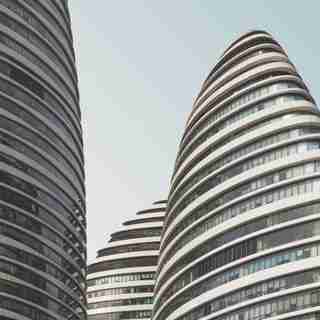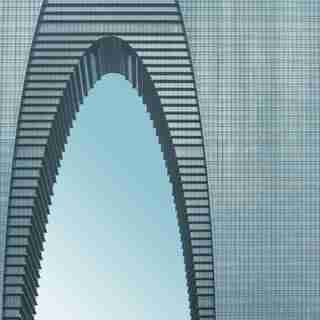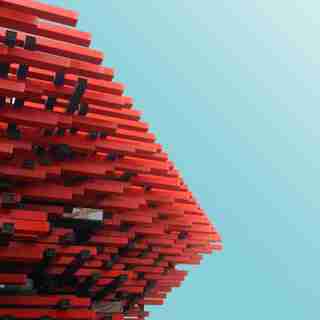Some of the most innovative buildings of the past 15 years can be found in China. The structures, by top architects such as Zaha Hadid, Steven Holl, Thomas Hetherwick, and Kengo Kuma, are striking works of design and engineering. In the new book Beautified China (Lannoo Publishers, $60), photographer and architect Kris Provoost celebrates daring designs across the country, highlighting the striking details that set these buildings apart.
“I was looking for unique shapes, unique configurations or buildings that simply standout in the city,” says Provoost. “The buildings in the Beautified China book are more than just buildings; they have the power to be more, to become a destination and gather people.” Provoost traveled to 16 cities in China to give a broad overview of the country’s architectural treasures. “It has taught me that there is an infinite supply of striking architecture in China, all built at a tremendous speed unimaginable in the west,” he says.
Provoost, who has worked at Zaha Hadid Architects and Büro Ole Scheeren, approached each building with an architect’s eye: “As an architecture photographer, the best part of my job is the opportunity to spend a large amount of time, sometimes three or four full days at a project, and try to understand it fully and photograph it in such a way that you can tell the story behind the building. I wouldn’t have been able to do this if I haven’t had the experience of designing architecture first.” Read on to see 10 of the buildings Provoost captured for the book.

Zaha Hadid Architects, Wangjing Soho (Beijing)
“This is a special project to me, as I had the opportunity to work on this at the beginning of my career,” says Provoost of ZHA’s Beijing towers, which opened in 2014. “To see it go from drawings on a screen to an actual building that thousands of people use on a daily basis is a unique experience. [It was] a project I had to include in the book.”

RMJM, Gate to the East (Suzhou)
International frim RMJM designed this office tower in Suzhou. “In China, symbolism is still an important factor in architecture,” says Provoost. “An enormous gate, effectively connecting two huge skyscrapers, is a good link to the ancient gates signifying ancient Chinese cities. The scale drew me to this project, and hence why I captured a large part of it showing many tiny windows.”

China Architecture Design & Research Group, Chongqing Guotai Arts Center (Chongqing)
“This arts center ticks a lot of boxes on what defines an iconic building,” the architects says of China Architecture Design & Research Group’s arts center in the Yuzhong District. “Unique form, eye-catching color, interesting details, and above all it stands out from every angle. I was immediately drawn to it because of the above factors. And also because it’s distinctly Chinese.”
gmp Architekten, Chongqing Grand Theater (Chongqing)
“When visiting Chongqing, it is hard to miss this theater,” he says of the building by gmp Architekten, which was completed in 2009. “Standing proud on its pedestal overlooking the city, it can come over as ‘hostile’ due to its rough shape and uniform material. But for me, this was the perfect premise. I wanted to capture what makes this a perfect building for the rough, hostile city that is Chongqing.”
Stufish Entertainment Architects, Wanda Movie Theme Park (Wuhan)
“Iconic architecture is often used to grab someone’s attention from a first glimpse. Yellow interconnected cylinders do just that,” he says of the Wanda Movie Theme Park by Stufish Entertainment Architects. “For me, it was important to capture the bright yellow color and show the unique shapes. One glimpse and you remember it: the real strength of iconic architecture.”
Zaha Hadid Architects, Galaxy SOHO (Beijing)
“Zaha Hadid’s projects are always unique, and make you wonder how they actually build this,” he says of Galaxy SOHO, completed in 2012. “This thought becomes even stronger when you roam around Beijing and see the rather generic forms, often draped in a gray layer of smog. Galaxy SOHO is a project that was so different, so unique for a city like Beijing that it really appears to be from a galaxy far away. For me, Galaxy SOHO is a project that defines the new Beijing.”
Steven Holl Architects, Linked Hybrid (Beijing)
“Beijing can appear generic and a lot of the same,” says Steven Holl. “Housing block after housing block in the same monochrome colors. Office tower after tower covered in transparent glass that feels more like impenetrable walls than actually windows. Steven Holl takes these uniform and rational buildings and gives them a twist, a public elevated loop connecting the many towers of the project into one. As an architect, I always find that idea of taking a known typology and providing a new refreshing twist an interesting concept.”
Heatherwick Studio, British Pavilion (Shanghai)
“[This] pavilion is hard to describe. What is it exactly?” he says of Heatherwick Studio’s British Pavilion, built for the 2010 Shanghai World Expo. “When I visited the Expo in 2010, I was immediately drawn to it because it was so different, so interlayered. [I was] glad I got to capture it before it eventually got demolished when the expo came to an end.”
He Jingtang, China Pavilion (Shanghai)
“As an architect and photographer, I was intrigued by how this pavilion (now one of the largest museums in Shanghai) was able to symbolize both the old and the new China,” he says of He Jingtang’s China Pavilion, which was also built for the 2010 Expo. “Scale-wise it definitely represents the new China. The stacking of the red bars is what drew my attention, and refers to the old construction methods of the ancient temples.”
SOM, Ningbo Bank of China Tower (Ningbo)
“Having lived around skyscrapers the past decade—quite a difference from growing up in Belgium, where most buildings don’t go higher than five floors—the high-rise typology interested me enormously,” says Provoost. “Unless you think completely differently about them, like Rem Koolhaas did for the CCTV headquarters in Beijing, the only way you can build, really, is vertical. And with thousands of them getting built across China, it is increasingly difficult to stand out—and let’s be honest, one of the most important purposes of a skyscraper is to stand out. When I photographed this tower in Ningbo, I was immediately focusing on the subtle twist. And how the simple façade strengthens that twist.”
Beautified China (Lannoo Publishers, $60).
